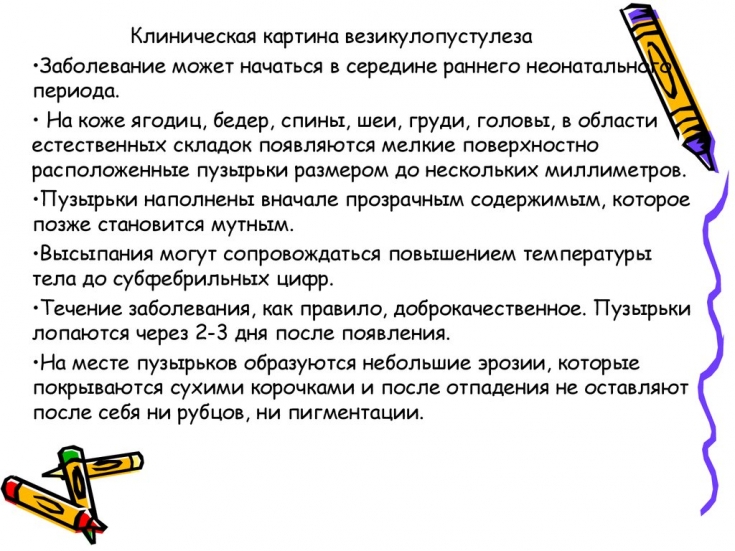Vesiculopustulosis (pyoderma) – this is a pustular lesion of the skin, namely the sweat glands.
In 90% of cases, the disease is diagnosed in newborns in the first days of life, since the skin of babies is sterile, which is a favorable factor for the reproduction of microbes.
Inflammatory foci are found on the hairy skin, in the folds, in the area of the collarbones and on the back. The diagnosis of this disease is simple and is confirmed by the history, characteristic manifestations and the results of laboratory diagnostics.
estet-portal.com will tell you all the details about pyoderma.
1. Causes of vesiculopustulosis and contributing factors
2. Methods for diagnosing vesiculopustulosis: visual and laboratory
3. Treatments for vesiculopustulosis and prohibited activities
Causes of vesiculopustulosis and contributing factors
The main causative agents of purulent lesions of the sweat glands are gram-positive (staphylococcus or streptococcus as the root cause of skin lesions) and gram-negative bacteria (Proteus, Escherichia coli, Klebsiella). Recently, mycotic vesiculopustulosis has been isolated.
The most common cause (80%) of infection is Staphylococcus aureus. This is due to the fact that among the medical staff of maternity hospitals and among incoming women in labor, such a phenomenon as carriage is common.
Having a pathogen on their skin, these people do not get sick themselves, but they can unwittingly carry a dangerous bacterial agent.
It is also worth mentioning the risk factors for bacterial damage to the sweat glands.
These include:
• decreased immunity in premature babies;
• High humidity and high room temperature;
• excessive wrapping;
• violation of the rules of child care (improper skin treatment, poor hygiene, not ironed rompers and undershirts).
The listed factors contribute to damage to the delicate and thin skin of the child. There are congenital and acquired vesiculopustulosis.
Congenital - diagnosed 2-3 days after birth, and infection comes from the mother (chronic infections).
Acquired - determined on the 5-7th day after birth.
Vesiculopustulosis diagnostic methods: visual and laboratory
The diagnosis of purulent lesions of the sweat glands can be made by characteristic symptoms, history and laboratory data. First of all, attention is drawn to the presence of a red rash, which is initially mistaken for prickly heat.
If it is not treated, then vesicles with transparent (serous) contents form at the mouth of the sweat glands.
A rim of red inflamed skin is determined around the vesicle. If the disease is not treated at this stage, then the contents of the vesicles become cloudy (purulent) – pustular stage. The pustules spread rapidly and coalesce.
After a few days, the pustules open up, followed by the formation of ulcers and crusts. By the way, with timely treatment, there will be no defects on the skin (pigment spots or scars).
The child's condition does not change much. Body temperature may rise up to 37.3 °C. With timely proper treatment, the disease will pass in 10 days.
To determine which microorganism caused the disease, you need to sow the biomaterial on a nutrient medium (contents of the pustule, blood). When a pathogen is detected, its sensitivity to antibiotics is determined.
Purulent lesion of the sweat glands is caused by bacterial and fungal microflora. Although it is easy to identify, it should be treated immediately, as untreated vesiculopustulosis can lead to sepsis.
Vesiculopustulosis Treatments and Do's and Don'ts
Children with this disease are treated by a pediatrician, and in case of exacerbation of the patient, they are transferred to the infectious diseases department and transferred to an infectious disease specialist. Uncomplicated forms of vesiculopustulosis are treated at home.
During the treatment of pyoderma, it is strictly forbidden to bathe the child in order to prevent the spread of the process.
Healthy adjacent skin areas are treated with furacillin and potassium permanganate solution. Treatment of the affected areas of the skin is carried out with antibacterial ointments (tetracycline and lincomycin) and aniline dyes (methylene blue, brilliant green).
When the process is generalized, broad-spectrum antibiotics, immunostimulants and vitamins of group B, C, A are prescribed. Treatment lasts 7-10 days.
If the treatment is not effective, and the child's condition worsens, then specific immunomodulatory therapy (gamma globulin, antistaphylococcal toxoid and plasma) is prescribed. Of the methods of physiotherapy, UHF therapy and UV irradiation have proven themselves well.
Don't bathe your baby if you have vesiculopustulosis! Treat the unaffected area of the skin with antibacterial solutions. For diseased areas – antibacterial ointments or dyes. If worsening, antibiotics are added. If it doesn't help – drugs for immunity.
Vesiculopustulosis – at first glance, a benign disease that can be easily identified and easily cured. But it can cause a number of complications (otitis media, pneumonia, omphalitis, pseudofurunculosis).
It is better not to wait for the appearance of staphylococcal pyoderma, but to properly care for the baby (daily bathing in a decoction of string and chamomile, ironing diapers, not wearing too many things on the child).
If the disease is still present – remember that with the right approach, it can be cured in 10 days.
Arm yourself with our advice, go to the doctor and your health will return!
Antibiotics for children: use them wisely
You might be interested in: Abs Workouts.







Add a comment